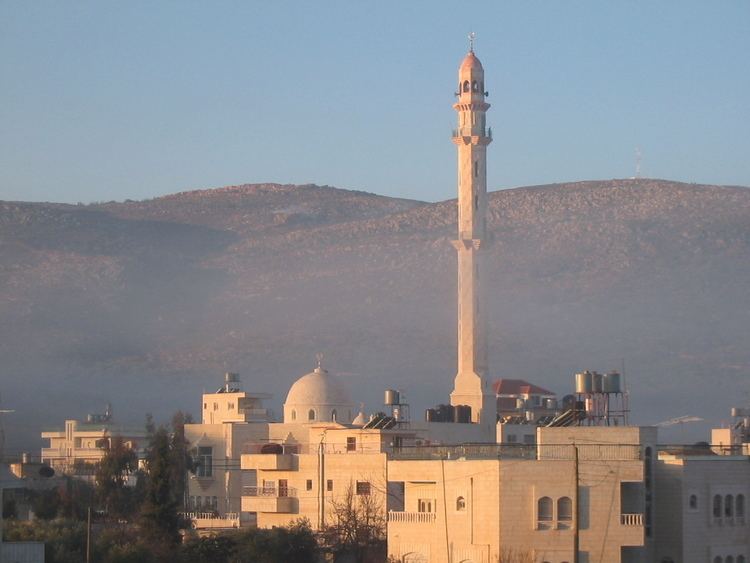Palestine grid 177/160 Name meaning Thormasia | ||
 | ||
Weather 13°C, Wind W at 8 km/h, 49% Humidity | ||
Turmus Ayya (Arabic: ترمسعيّا) is a Palestinian town located in the Ramallah and al-Bireh Governorate in the West Bank. Its surrounding villages are Sinjil (سنجل), Khirbet Abu Falah (خربة ابو فلاح) and the Israeli settlement of Shilo. According to the Palestinian Central Bureau of Statistics (PCBS), it had a population of 3,736 in 2007.
Contents
- Map of Turmus Aya
- Geography
- Etymology
- History
- Ottoman era
- British Mandate era
- 1948 1967
- 1967 present
- Education
- Economy
- Local services
- References
Map of Turmus Aya
Geography
Turmus Ayya is located 22 kilometres (14 mi) northeast of the city of Ramallah. Its jurisdiction is about 18,000 acres (73 km2). Turmus Ayya is 720 m above sea level. It is also the northernmost town in the Ramallah District. Turmus Ayya's climate is similar to that of the central West Bank, which is rainy in the winter, and hot and humid in the summer.
Etymology
Turmus Ayya appears in older maps and reference books, such as Mustafa Murad al-Dabbagh's encyclopedia "Palestine, Our Land,” as Thorinasia. The name is broken down into three parts - Tur-Massh-Ayya: Tur means mountain, Massh is the pulp left after squeezing grapes, and Ayya means humid. Alternately, the name might come from the Latin: Terra (land) and Mesia (Messiah), hence "Land of the Messiah."
History
Potsherds from the late Iron Age (8 -7th century B.C.E.) period and later have been found, and it is estimated that the village has existed continuously since then.
Turmus Ayya is generally accepted as being the Turbasaim in Crusader sources.
Just North-East of Turmus Ayya is Kh. Ras ad Deir/Deir el Fikia, believed to be the Crusader village of Dere.
In 1145, half of the income from both villages were given to the Abbey of Mount Tabor, so that they could maintain the church at Sinjil. In 1175, all three villages; Turmus Ayya, Dere and Sinjil, were transferred to the Church of the Holy Sepulchre.
Ottoman era
In 1517, Turmus Ayya was incorporated into the Ottoman Empire with the rest of Palestine, and in 1596 it appeared in the tax registers as being in the Nahiya of Quds of the Liwa of Quds. It had a population of 43 households, all Muslim, and paid taxes on wheat, barley, olive trees, vineyards, fruit trees, goats and/or beehives.
French explorer Victor Guérin visited the village in 1870, and found here ancient cisterns, cut stones built up in the houses, a broken lintel with a garland carved upon and the fragments of a column. He further noted that the village had about seven hundred inhabitants, and was administered by two sheikhs and divided into two different areas. Some ancient cisterns were almost completely dry, and women were forced to fetch water either from Ain Siloun, or Ain Sindjel. An official Ottoman village list from about 1870 showed that "Turmus Aja" had a total of 88 houses and a population of 301, though the population count included only men.
In the Palestine Exploration Fund's Survey of Western Palestine in 1882, Turmus 'Aya was described as "a village on a low knoll, in a fertile plain, with a spring to the south. The village is of moderate size, and surrounded by fruit trees. On the south at the foot of the mound is the conspicuous white dome of the sacred place."
British Mandate era
In the 1922 census of Palestine, conducted by the British Mandate authorities, Turmus Ayya had a population of 707, all Muslim, while in the 1931 census, the village had 185 occupied houses and a population of 717, all Muslims except one Christian woman.
In 1945 the population was 960, all Muslim, while the total land area was 17,611 dunams, according to an official land and population survey. Of this, 3,665 were allocated for plantations and irrigable land, 7,357 for cereals, while 54 dunams were classified as built-up areas.
1948-1967
In the wake of the 1948 Arab–Israeli War, and after the 1949 Armistice Agreements, Turmus Ayya came under Jordanian rule. The Jordanian census of 1961 found 1,620 inhabitants, including seven Christians.
1967-present
After the Six-Day War in 1967, Turmus Ayya has been under Israeli occupation. According to an Israeli census in 1967, there were 1,562 people. By 1989, the population rose to 5,140. The original residents of Turmus Ayya come from the following clans: Abu-Awad (أبوعواد), Ijbara (اجبرا), Kük(كوك), Hazama/Nofal(حزمة) or Shalabi (شلبي).
In December 2014, the town was the site of the controversial death of Palestinian official Ziad Abu Ein, during a protest against Israeli occupation.
Education
There are three schools in Turmus Ayya: a girls school (grades 1–12), a boys school (grades 1–12) and a co-ed school (grades 1–4). There is also a community center housing a pre-school and kindergarten.
Economy
The economy is based primarily on olive orchards and fruit trees. It is also the home of the Turmus Aya Equestrian Club.
Local services
Turmus Ayya is governed by a local council. Water is supplied by Ramallah Water Systems; electricity by Jerusalem Energy; and phone service by the Palestinian Communications Company. Turmus Ayya has a new hospital on the northern side of town (al-Muntazah). There are two mosques in the town: Masjid Abu Bakir Asadeek and the newer Masjid al Farook. An older, non-functioning mosque is Al-Masjid Alqadeem ("the old mosque)."
